- WORLD BANK KICK-OFF INSPECTION OF USMID PROGRAM IN UGANDA
- ALGERIA MINISTER RECIEVED HARBOR ENERGY CEO OVER ENERGY PARTNERSHIP
- CAN INNOVATION OUTRUN DROUGTH IN MOROCCO ONGOING WATER MANAGEMENT CRISIS
- SCZONE SIGNED DEAL WITH CHINESE INVESTORS FOR IRON PRODUCTS PROJECTS IN EGYPT
- WESTPROP HOLDING LIMITED SET TO EMBARKED ON PIPELINE PROJECT IN ZIMBABWE
AN APPROACH TO BUILDING RESILIENT CIVIL ENGINEERING INFRASTRUCTURE FOR THE FUTURE IN DIFFICULT TERRAIN
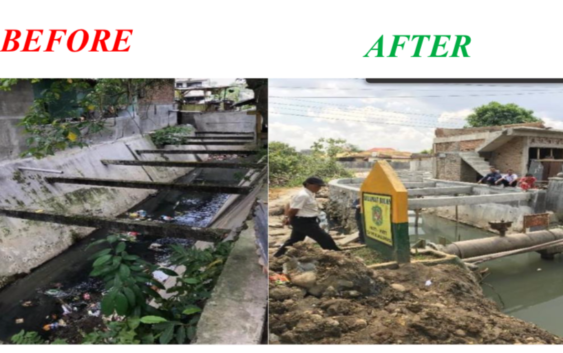
A Paper Delivered at the 2019 Engineering Week Ceremony of The Nigerian Society of Engineers, Port Harcourt Branch on Tuesday 26th November 2019
Our world and nation today face an increasingly complex set of risks that are interwoven into all facets of our businesses, infrastructures, and communities. The threat of climate change, flash floods, sea surge––tsunami floods, financial instability, pandemics, cybercrime, social unrest, terrorism, hostage taking, and other disruptive events that flow from our participation in a global and local economy has become a part of our everyday lives.

While we continue to work toward a safer and more secure world, the reality is that we must address emerging risk landscape with diligence, commitment, and the understanding that we cannot reroute climate change and floods, intercept external disruptions or prevent every natural disaster. To succeed in this world of uncertainties, we must be prepared to mitigate uncertainties and balance risk, and approach all hazards from the purview of prevention, preparedness, response, and recovery.
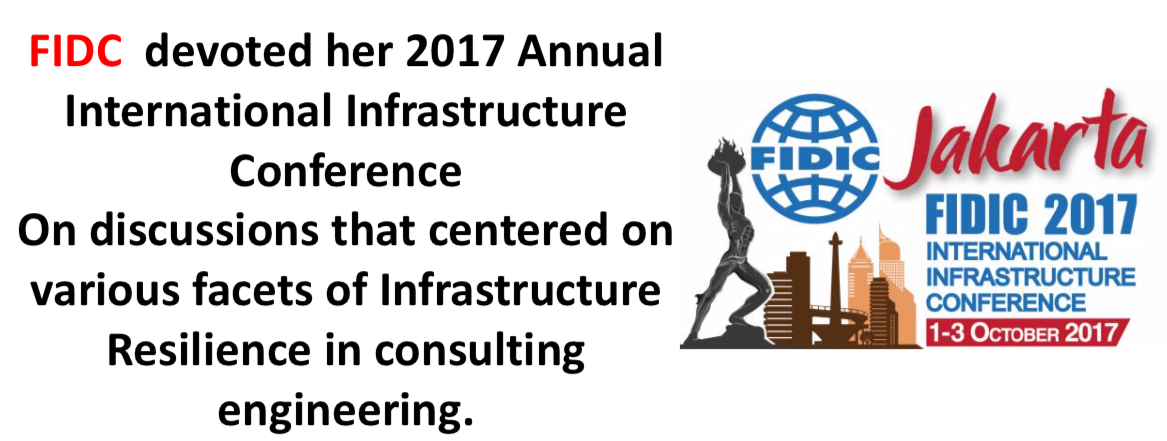
In recent years, the subject of resilience in infrastructure has generated so much interest in both national and international fora. The International Federation of Consulting Engineers (FIDIC) devoted her 2017 annual International Infrastructure Conference held on 1st to 3rd October in Jakarta, Indonesia on discussions that centered on various facets of Infrastructure Resilience in consulting engineering. It was at this conference that my eyes were opened to the understanding of the importance of resilience in infrastructure. The burning issues that were discussed in that conference were the unprecedented effects of climate change, external disruptions such as terrorist attacks and natural disasters, such as building collapses, earthquakes, floods, and rising sea levels.
Resilience provides the bridge between the possible and the ideal. It is a fundamental strategy that makes our businesses stronger, our communities better prepared, and our nation more secure. It is the most flexible and cost-effective strategy to ensure continuity of services and functionality of infrastructure in disruptive situations, and I am glad The Nigerian Society of Engineers, Port Harcourt Branch has gathered us here today to reason together on this subject.
Infrastructure resilience, as defined by the USA, is the ability to reduce the magnitude and/or duration of disruptive events. The effectiveness of a resilient infrastructure depends on its ability to anticipate, absorb, adapt to, and/or rapidly recover from a potentially disruptive event.
In the context of critical infrastructure, resilience refers to:
- Coordinated planning across sectors and networks
- Responsive, flexible and timely recovery measures and
- The development of an organizational culture that can provide a minimum level of service
during interruptions, emergencies, and disaster, and return to full operations quickly.

Resilience is the capacity of a system to prevent a crisis occurrence, and when a crisis occurs, the capacity to absorb the impact and recover rapidly to the normal state. In other words, infrastructures that are not resilient could be said to be “Brittle.” Brittle in the sense that such infrastructure only meets the temporary need of the present and compromises the ability of future generations from meeting their own needs as it would crumble when hit with external disruptions and/or natural disaster. Comfort, Boin and Demchak (2010) interestingly identified three types of resilience: “emotional resilience” which considers resilience as a character trait in a person, organization, or community; “engineering resilience” which considers resilience as a system attribute that allows the system to return to its original stable state as quickly as possible; and “ecosystem resilience” which considers the stable regime through learning and adaptation.
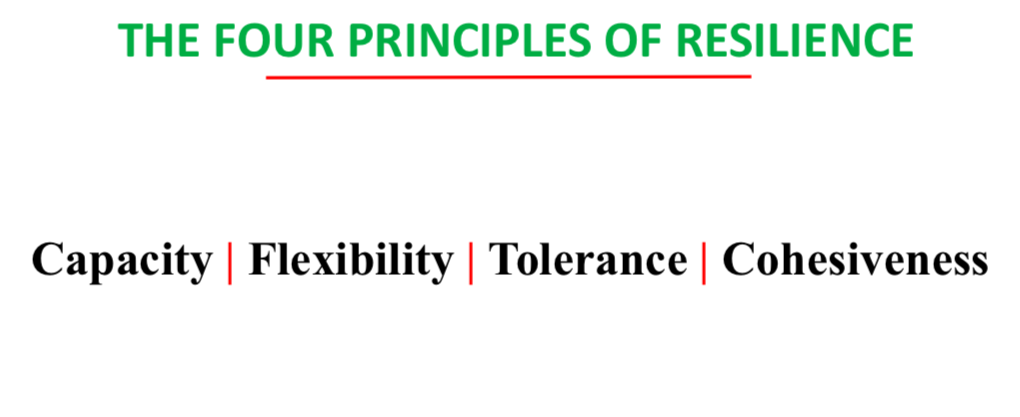
The four principles of resilience: Capacity, Flexibility, Tolerance, and Cohesiveness.
Capacity: Capacity which is the first and perhaps the most important principle of resilience essentially, denote that all infrastructures should have the capacity to withstand disruptions, such as hurricanes and floods. Capacity therefore, includes not only the ability to absorb such disruptions but also a margin of additional ability to cope with disruptions larger than anticipated. It includes both physical and functional redundancy so that the infrastructure will have alternative ways to survive. The more ways there are, the more resilient the infrastructure is.
Flexibility: In resilient infrastructure, flexibility essentially means that the infrastructure system should be able to reorganize itself. The reorganization includes the ability of the infrastructure to elevate levels of authority during a disruption. This elevation employs a system in which, as the severity of an emergency increases, the authority rises from the lowest level to the highest decision- making level.
Tolerance: Tolerance in resilient infrastructure essentially means that the infrastructure will not immediately lose all of its capability following a disruption, but will degrade gradually. Tolerance depends, to a large extent, on localized capacity. For example, many hospitals have their independent power supplies in case of public power supply failure due to major disruptions.
A critical aspect of tolerance worthy of note is “loose coupling.” It is an aspect of tolerance that ensures that when one node of an infrastructure element fails, that failure will not immediately propagate to and/or affect other nodes. Another capability in tolerance is “drift correction” which essentially means that disruptions can be avoided or at least minimized by awareness of their occurrence in enough time that corrective or compensatory action can be taken.
The use of sensors to warn of an impending train collision, sensors in pipeline to detect likely fissures are examples of drift correction. It can be used to prevent or reduce the harmful effect of an imminent disaster.
Cohesiveness: Cohesiveness in resilient infrastructure essentially is about how well the nodes of the infrastructure related to one another. This relationship is referred to as “cross-scale interaction.” The first level is communication, which asks, specifically, if the nodes “talk to one another.” The second level of cohesiveness is “corporation.” Even with no formal ties, the nodes of infrastructure should possess the initiative, and capabilities needed to cooperate.
The third and highest level of cohesiveness encompasses “inter-element collaboration”, which includes formal agreements between the nodes to both help and provide resources to one another.
The Four Common Construct (Attributes) of Infrastructure Resilience:
1. Robustness —Ability to absorb shocks and continue operating.
2. Resourcefulness —The ability to skillfully manage the crisis as it unfolds
3. Rapid Recovery —The ability to get services back as quickly as possible and
4. Adaptability —The ability to incorporate lessons learned from past events to improve resilience.
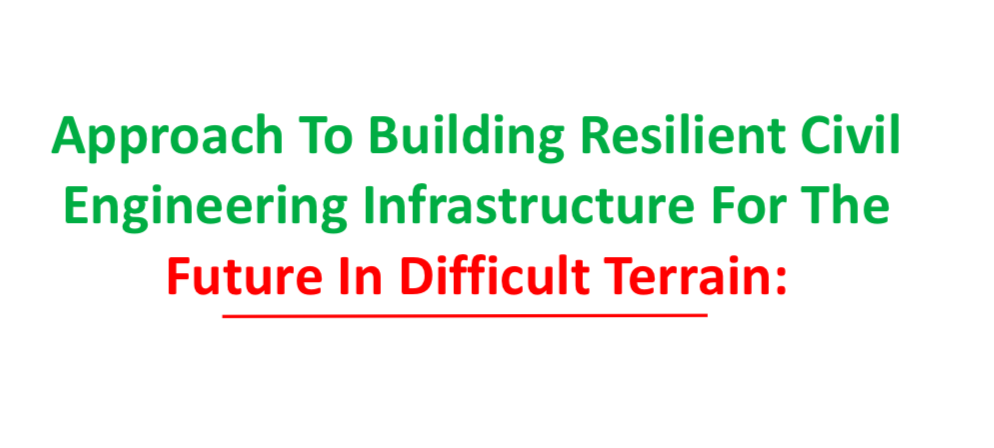
There are many approaches via which we can build resilient civil engineering infrastructure today and for the future in difficult terrain:
1. Design With Resilience: Resilience should be considered and made a thing of top priority whenever any infrastructure is to be built. Historically, most of the infrastructures that we have on ground today were built without resilient thinking. They were built just to meet the present need without any thought of the future nor external disruptions or natural disasters.
In Rivers State, for example, burial and marriage ceremonies are held on major roads because all lands have been sold for construction purposes without any thought of the need for recreational parks in the future. We need spatial planning framework to redirect development away from high- risk areas. Our highways should be dualized with high elevation across identified lowland water channels and more lanes with increased sighting distance because of vulnerability to criminal activities on our roads.
Take for example, if the Omoku–Elele road was conceived, designed and constructed as a dual carriageway with possibly six lanes, it would have countered the incessant kidnappings and insurgency that disrupted business activities for so long in that area. The design of our intercity roads, residences, and city construction activities must factor in all these disruptive elements, and should have mandatory provision for good drainage system, deliberate artificial lakes, and canals that can take water in cases of flood.
Transformers should be installed on higher platforms and boreholes should be built with upstanding concrete platforms and wall enclosure above anticipated maximum flash flood water levels. Engineers should incorporate building redundancy, by including sacrificial components that are “designed to fail” in structures.
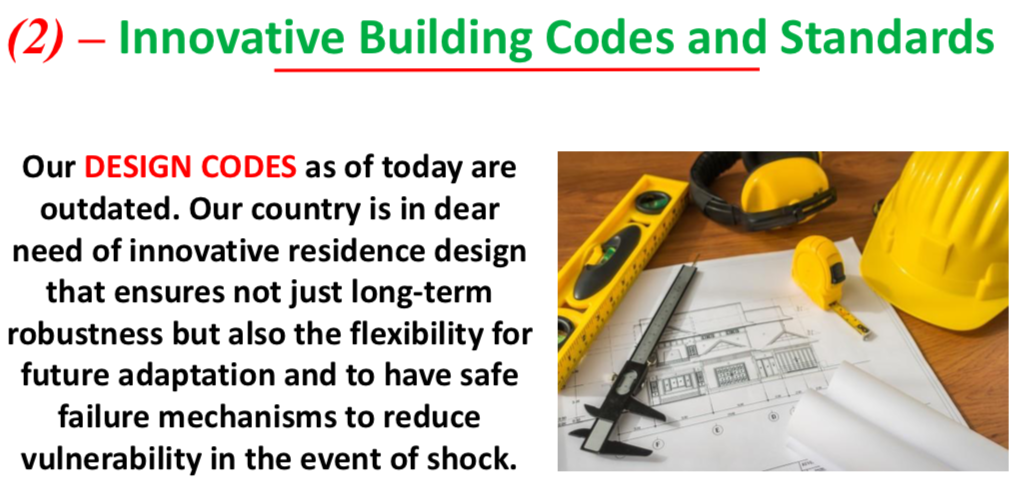
2. Innovative Building Codes And Standards: Our design codes as of today are outdated. Our country is in dear need of an innovative resilient design that ensures not just long-term robustness but also the flexibility for future adaptation and to have safe failure mechanisms to reduce vulnerability in the event of a shock. Building codes and land-use regulations are proven effective tools to promote safety in cities and reduce risks from natural disasters. Rather than rigid adherence to standards and guidelines which may only reflect evidence of past events, our research, development and demonstration centers in our institutions of higher learning must swing into action and propose innovative design initiatives that would help mitigate the dangers that we are facing in our cities and villages today.
In civil engineering, we base our designs mostly on the British Design Codes BS 8110 and more recently on the Eurocode, but we need to domesticate theses code to meet our national situations and conditions. The Eurocode, for example, requires us to develop a National Annex, where we should have data and parameters for local materials and conditions. The characteristic wind load for the design of concrete structures, for example, should be determined and included in that national annex.
I know that there is work in progress to domesticate foreign codes by COREN, NSE, SON, all institutions in the built and natural environment, and the MDAs, but greater work is required from the research institutions and the citadel of learning to engage seriously in research to produce our standards and with special attention and considerations to infrastructure resilience.
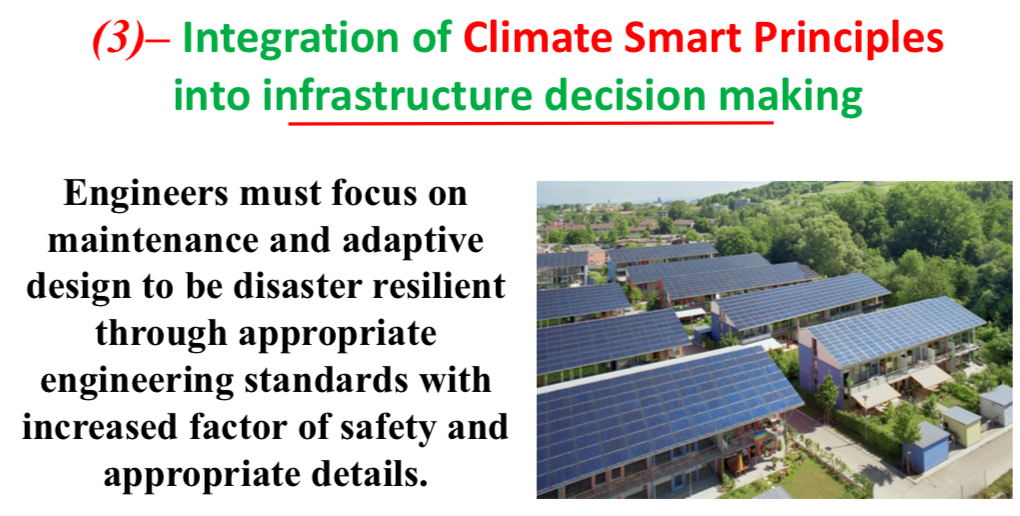
3. Integration Of Climate-Smart Principles Into Infrastructure Decision Making:
Infrastructure can be designed to be disaster resilient through appropriate engineering standards with increased factor of safety and appropriate details. We need infrastructure project and policy appraisals, including strategic Environmental Impact Assessment, appropriate modeling results, and data with the package of management measures such as raising the height of bridges to account for the sea-level rise or using infrastructure such as protecting or enhancing natural drainage systems.
Take, for example, a farming and fishing community––Oreke town in Kogi state has been seating on flood water for over two months now. They have school buildings on elevated floors; the upper floors housing some residence of the community, while lower floor seating on floodwater is their swimming pool.
Infrastructure Resilience requires that all elemental structural component for such school building should be given special design considerations to absorb the flood water shocks over a long period and remain stable.
Conclusion: Infrastructure resilience is a shared responsibility of the private sector, government, communities, and individuals. The growing complexity of and interconnectedness of our critical infrastructures, the uncertainty of the emerging risk landscape, and the practical limitations of private companies to address certain risks all underscore the need for collaboration between the public and private sectors to strengthen infrastructure resilience.
In a difficult terrain like ours in Niger Delta Region, engineers in general and civil engineers in particular should not only think out of the box, but step outside the box and feel the impulse of our society in the face of risk landscape, disruptive events, and collaborate with all stakeholders to build resilient civil engineering infrastructure.
As a people or group, we all have a distinct function and unique capabilities. And if we play our roles well, we can build resilient infrastructure for the future even in difficult terrain.
So, distinguished engineers and guests here present, to build resilient civil engineering infrastructure for the future in difficult terrain like ours in the Niger Delta, we must:
Number 1: Design With Resilience
Number 2: Formulate Innovative Building Codes And Standards
Number 3: Integrate Climate Smart Principles Into Infrastructure Decision Making.
Thank you!!
Written by:

Engr. G. C. Okoroma, FNSE, FNICE, FNIHE, MNIStructE, MASCE, MIDiagE, JP,
Chairman/CEO, Gambeta Groupe Limited.

